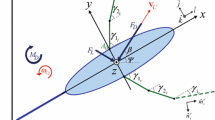Abstract
A robotic fish driven by oscillating fins, “Cownose Ray-I”, is developed, which is in dorsoventrally flattened shape without a tail. The robotic fish is composed of a body and two lateral fins. A three-factor kinematic model is established and used in the design of a mechanism. By controlling the three kinematic parameters, the robotic fish can accelerate and maneuver. Forward velocity is dependent on the largest amplitude and the number of waves in the fins, while the relative contribution of fin beat frequency to the forward velocity of the robotic fish is different from the usual result. On the other hand, experimental results on maneuvering show that phase difference has a stronger effect on swerving than the largest amplitude to some extent. In addition, as propulsion waves pass from the trailing edge to the leading edge, the robotic fish attains a backward velocity of 0.15 m·s−1.
Similar content being viewed by others
References
Brader C M. The locomotion of fishes. Zoologica, 1926, 50, 159–297.
Webb P W. The biology of fish swimming. In Maddock L, Bone Q, Rayner J M V (eds), Mechanics and Physiology of Animal Swimming, Cambridge University Press, Cambridge, UK, 1994, 45–62.
Blake R W. The swimming of the mandarin fish Synchropus picturatus (Callionyiidae: Teleostei). Journal of the Marine Biological Association, 1979, 59, 421–428.
Vogel S. Life in Moving Fluids: The Physical Biology of Flow, Princeton University Press, Princeton, USA, 1994.
Heine C E. Mechanics of Flapping Fin Locomotion in the Cownose Ray, Rhinoptera Bonasus (Elasmobranchii: Myliobatidae), PhD Dissertation, Duke University, USA, 1992.
Rosenberger L J. Pectoral fin locomotion in batoid fishes: Undulation versus oscillation. Journal of Experimental Biology, 2001, 204, 379–394.
Hishinuma K, Konno A, Mizuno A, Koichi H, Kawada M. Analysis method of flapping fin motion for mantalike underwater robot. Proceedings of the 7th International Symposium on Marine Engineering, Tokyo, Japan, 2005.
Yamamoto I. Research on bio-maneuvering type underwater vehicle — development of life-like swimming robotic fish. Proceedings of the 18th Ocean Engineering Symposium, Tokyo, Japan, 2005.
Toda Y, Ikedab H, Sogihara N. The motion of a fish-like underwater vehicle with two undulating side fins. The 3rd International Symposium on Aero Aqua Bio-Mechanisms, Ginowan, Japan, 2006.
Low K H, Willy A. Biomimetic motion planning of an undulating robotic fish fin. Journal of Vibration and Control, 2006, 12, 1337–1359.
Xu Y C, Zong G H, Bi S S, Gao J. Initial development of a flapping propelled unmanned underwater vehicle. Proceedings of the 2007 IEEE Interntional Conference on Robotics and Biomimetics, Sanya, China, 2007, 524–529.
Hu T J, Shen L C, Lin L X, Xu H J. Biological inspirations, kinematics modeling, mechanism design and experiments on an undulating robotic fin inspired by Gymnarchus Niloticus. Mechanism and Machine Theory, 2009, 44, 633–645.
Hu T J, Shen L C, Low K H. Bionic asymmetry: From amiiform fish to undulating robotic fins. Chinese Science Bulletin, 2009, 54, 562–568.
Yang S B, Han X Y, Zhang D B, Qiu J. Design and development of a kind of new pectoral oscillation robot fish. Robot, 2008, 30, 508–515. (in Chinese).
Zhang D B. Research on the Underwater Bionic Undulatory-Fin Propulsor and Its Control Method, PhD Dissertation, National University of Defense Technology, Changsha, China, 2007. (in Chinese)
Low K H. Solution schemes for the system equatiosn of flexible robots. Journal of Robotic Systems, 1989, 6, 383–405.
Low K H, Lim T M, Chai G B. Experimental and analytical investigations of vibration frequencies for centre-loaded beams. Computers and Structures, 1993, 48, 1157–1162.
Low K H. A further note on closed-form formulas for fundamental vibration frequency of beams under off-centre load. Journal of Sound and Vibration, 1997, 207, 132–135.
Low K H. Modelling and parametric study of modular undulating fin rays for fish robots. Mechanism and Machine Theory, 2009, 44, 615–632.
Zhang Y H, Song Y, Yang J, Low K H. Numerical and experimental research on modular oscillating fin. Journal of Bionic Engineering, 2008, 5, 13–23.
Author information
Authors and Affiliations
Corresponding author
Rights and permissions
About this article
Cite this article
Yang, Sb., Qiu, J. & Han, Xy. Kinematics Modeling and Experiments of Pectoral Oscillation Propulsion Robotic Fish. J Bionic Eng 6, 174–179 (2009). https://doi.org/10.1016/S1672-6529(08)60114-6
Published:
Issue Date:
DOI: https://doi.org/10.1016/S1672-6529(08)60114-6




